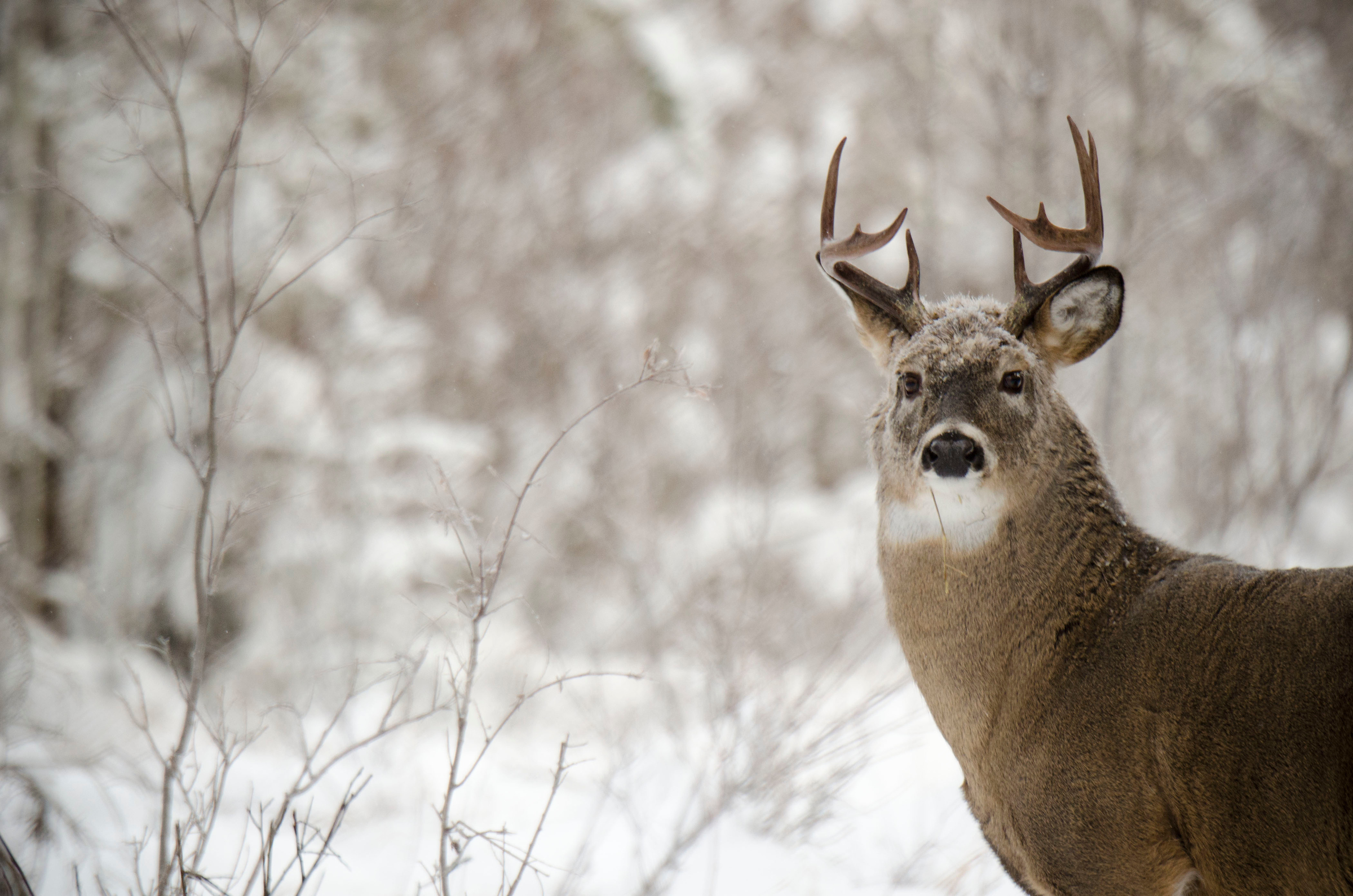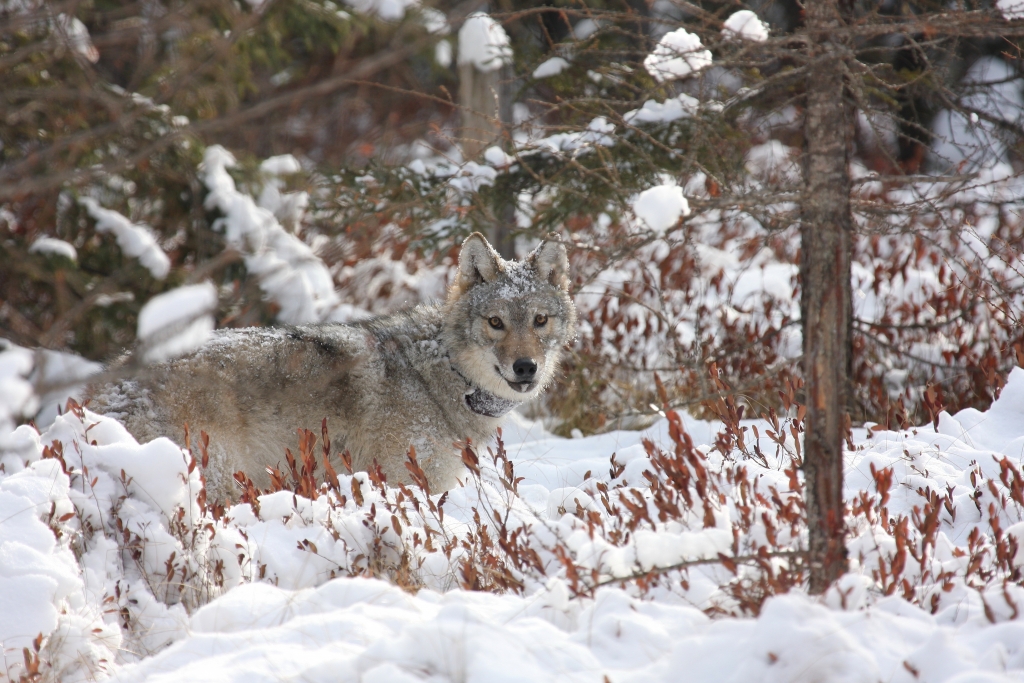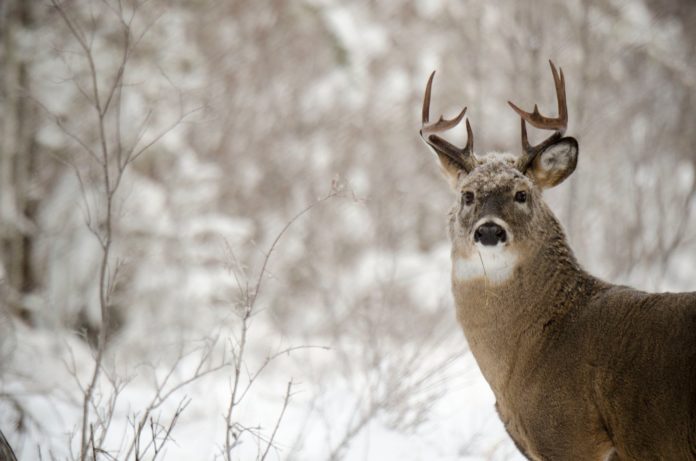
Stu Osthoff of Ely, Minnesota, first hunted the state’s Arrowhead region—an expansive wildland of boreal forests and lakes in the northeastern corner of the state—in 1978 at age 22. He recalls being awed by big antlers nailed to barns and garages wherever he drove. He married locally soon after and raised three kids on a former farm south of town.
Starting in the late 1990s, Osthoff regularly wrote articles for hunting publications and his family’s Boundary Waters Journal magazine proclaiming his region No. 1 for public-land whitetails. He had the pelts to prove it. He and his wife, Michele, adorn their home with shoulder mounts of plush-caped, thick-antlered whitetails. They shot some of them in an adjoining state forest, and others 50 miles north in the Superior National Forest and Boundary Waters Canoe Area Wilderness.
Since 2012, however, the Osthoffs have added only one buck to their pine-board paneling: a big nontypical he shot in 2016 in the BWCAW. Osthoff, 65, hunts as hard as ever in those forests, but no longer sees enough whitetails, let alone mature bucks, to laud the hunting.

“It really declined the past 10 years,” Osthoff says. “They get run down during the rut, and then they’re vulnerable to deep snow and wolf predation. We still see a couple of big bucks on our land, but they really declined up in the Boundary Waters. Those tough winters—especially in 2013-14—took a heavy toll on bucks 4½ and older.
“I guide a canoe trip each October up there as the leaves fall,” Osthoff continues. “I hunt grouse and scout deer back in those hinterlands. Where I used to see good deer sign, I now see zero sign, besides the scars of 10-year-old rubs. I used to fill my canoe with deer and moose [antler] sheds. I seldom find sheds anymore.”
Osthoff attributes much of the decline to harsh winters, with conditions typically worsening eastward toward Lake Superior, which creates its own weather patterns. To measure winter’s impacts, the Minnesota Department of Natural Resources tracks snow depths and air temperatures annually from Nov. 1 through May 31. The DNR’s winter severity indexes rated the past 10 winters “severe” for much of the region. The only recent winters with “mild” ratings were 2011-12 and 2020-2021.
Hunting seasons corroborated those ratings. Northeastern Minnesota’s buck kill plunged 57 percent over the past decade. Harvest data for the region’s five northernmost management units (areas 117, 118, 126, 130, and 131) show rifle hunters registered a combined 1,958 bucks in 2010. The region’s buck kill then slid 48 percent to 1,010 in November 2014 after a killer winter, and then to 846 bucks in November 2020, the most recent year with complete WSI data. (See below for charts of this data.)
Declining Whitetail Numbers in the North Country
The boreal forests of neighboring Wisconsin, as well as Michigan’s Upper and Lower peninsulas, showed similar nosedives. Gun and archery hunters in northern Wisconsin registered a combined 67,560 deer in 2011. The harvest then slid 46 percent to 36,235 during the 2014 deer seasons after consecutive backbreaking winters. The herd grew slowly since, and a smaller hunting army registered 52,636 deer in 2021.
The Michigan DNR, meanwhile, documented a declining buck kill the past 35 years in the U.P. It sank to about 24,000 in 2009, rebounded to about 35,000 in 2012, and then crashed to about 17,000 in 2014. The buck harvest then rose to 30,000 in 2017 and 2018, before falling back to about 25,000 in 2019. In Michigan’s Lower Peninsula, the buck kill since 1985 has consistently followed the same downward fluctuations documented in the U.P. Unlike the U.P., Wisconsin and Minnesota, however, the Lower Peninsula can’t blame deer declines on wolves.

Wolves and Northwoods Deer
Gray wolves long ago re-established themselves in the Upper Great Lakes states, at least enough to warrant wolf seasons from 2012 to 2014 in Minnesota and Wisconsin, and 2013 in Michigan. Wisconsin also held a hunt in February 2021 that exceeded harvest quotas, which contributed to the 2021-22 Wisconsin season getting held up in court. Current estimates put the region’s wolf population at 4,500, with roughly 650 in the U.P., 1,200 in Wisconsin, and 2,700 in Minnesota. And although predation is the leading fawn killer in those states’ boreal forests, research shows fawns get hit hardest by wolves and black bears in Minnesota, bears and bobcats in Wisconsin, and coyotes and bears in the U.P.
“Wolves make an impact, and they probably explain why I seldom get trail-cam photos of the same mature buck two years in a row,” says 58-year-old Mike Kolbeck, a longtime Boundary Waters canoe-trip guide who has hunted deer along the Echo Trail over 15 years. “But when I’m hunting and I find wolf sign, I know deer must be around somewhere. Wolves have to hunt too, and we can’t do much about it. Even when Minnesota held wolf seasons [from 2012 to 2014], only one wolf got taken in the areas I hunt. That won’t make the herd bounce back.”

Of the 915 wolves shot or trapped across Minnesota those three years, 260 (28 percent) came from northeastern Minnesota. Maps with color-coded dots show the kill sites, which are seldom concentrated. The DNR estimated Minnesota’s 2019-2020 wolf population at 2,700, with a 90 percent confidence interval. That means the actual number was likely somewhere from 2,244 to 3,252 statewide. Wolf estimates after the 2012 to 2014 hunting/trapping seasons were 2,200 to 2,400. Osthoff doesn’t debate those estimates.
“I wish there weren’t so many wolves because I’m a deer hunter,” he says. “But I’m out there a lot, and from what I see their population is stable. If you hunt them intentionally, good luck. Most wolves taken in my area [from 2012 to 2014] were trapped or shot opportunistically. You might feel better about things if you get one, and maybe you’ll put some fear into them, but you won’t affect their population.”
So what is the wolf’s impact on whitetails? Let’s look back to a study from the early 2000s when whitetail numbers leaped from the pit to the penthouse. The winter of 1997-98 was mild, and the next 15 years brought only one “truly bad” winter (2004-05), which exceeded 140 WSI points. “Everyone loved those years,” says Tom Rusch who retired from the Minnesota DNR in November 2021 after working 34 years as a Northwoods wildlife manager. “We issued antlerless tags for up to five deer in some areas. No one talked much about wolves through all that.”
The herd proved incredibly fertile. Just to the west in north-central Minnesota, the DNR’s 1991-2005 research project was monitoring nearly 500 adult does fitted with radio-transmitting collars. The unprecedented study, which was three to six times longer than many similar projects, revealed 90 percent pregnancy rates in yearlings (18 months old during their first breeding season), and 100 percent in does 2½ to 15½ years old. Further, over half delivered twins.
“We didn’t see much decline in productivity for older does until after age 10, and then they had smaller newborns that didn’t survive as well,” says Glen DelGiudice, a deer project leader in research for the Minnesota DNR. “Those pregnancy rates put a lot of fawns on the ground and, based on previous research, we’re confident 38 percent to 45 percent of them reached a year old. Fawns are especially vulnerable their first few days, but then their odds improve. They’re the wolf’s main prey, and many die from age 1 to 2, but their survival rates stabilize and stay strong from age 2 to 6½, before gradually declining until they’re gone by 16½ to 17.”
DelGiudice’s research area was often open to antlerless hunting, and hunters killed 23.4 percent of the study’s collared does, slightly less than what wolves killed, 24.4 percent. On average, however, hunters killed more prime-age does (5.6 years) than did wolves (7.96 years).
DelGiudice says each wolf requires biomass equivalent of 15 to 17 adult deer annually, but they meet that need by eating what’s available, w/hether it’s fawns, moose, beavers or snowshoe hares. So let’s do the math: Minnesota has about 3,000 wolves. If they ate nothing except adult deer, they’d remove 45,000 to 51,000 whitetails annually. For perspective, Minnesota hunters from 2010 through 2020 registered a statewide average of 150,313 deer annually (81,893 bucks and 68,440 antlerless).
Meanwhile, the state has roughly 300,000 adult deer in wolf country during a given year. Assuming that roughly half the herd is females, they’d give birth to about 225,000 fawns in spring. And assuming well-documented recruitment rates of 38 percent to 45 percent — which subtracts 123,750 to 139,500 fawns by age 1 because of wolves, bears, coyotes, bobcats, illness and malnutrition — the herd still increases to 385,500 to 401,250 deer. Worst-case scenario: Wolves reduce the north country deer herd to 334,500, a conservative net gain of 34,500.
Winter Kill and Whitetails
Rusch, the retired wildlife manager, still hears plenty about wolves, but says deer numbers depend mostly on the depth and duration of snow cover.
“Most people’s eyes glaze over when you say ‘winter severity index,’ explain the point system, and why 120 points makes a winter ‘severe,’” Rusch says. “I just say a bad winter for deer is a good winter for snowmobiling. The longer you have good riding conditions, the more deer will struggle.”
Rusch says a typical winter brings 15 inches of snow by Dec. 15, a depth that starts stressing deer. The deeper the snow and the longer it lasts, the more deer die from malnutrition and predation. That happens whether winter starts at Thanksgiving and stretches into early April, or starts New Year’s Day and lasts till May. Fawns start succumbing to winter conditions in early March, given they have the least fat and shortest legs. Mature bucks fall soon after, given they burned off their fat by chasing does in November. Does fall last, given they enter winter with about 11 percent body fat to help nourish fawns they’re carrying.
Rusch recalls deer dying into the Memorial Day weekend during the infamous 1995-96 winter, which inflicted a 32 percent mortality rate on adult does monitored during a 15-year DNR research project led by DelGiudice. That winter generated WSI scores above 180—60 points higher than the “severe” threshold—across northern Minnesota. The following 1996-97 winter was nearly as harsh, generating WSI scores above 160 across the Arrowhead region.
“We basically lost all our fawns and mature bucks those years,” Rusch says. “The worst winters for predation have 26 to 30 inches of snow all season. The herd dropped into a hole. We had two tough winters and a poor mix of winter habitat, and combined it with a hungry wolf population. Then when black bears came out of hibernation, they found plenty of weak or dead deer to eat.”

Declining Hunter Numbers
As the deer herd fell regionally the past decade, so did hunter numbers, even though Northwoods hunting pressure is historically light compared to regions downstate or “below the bridge.” Further, gun-deer license sales from 2010 to 2020 fell 7 percent in Minnesota (379,966 to 354,023), 5 percent in Wisconsin (600,363 to 569,203), and 9.5 percent in Michigan (623,158 to 564,070).
Folks in northeastern Minnesota noticed. Hunters on the Echo Trail in the 1990s and 2000s saw trucks, wall tents, and camper-trailers parked at trailheads, pull-outs, and a nearby lodge. Those sites now sit empty, and the lodge closes before deer season. “When guys hear only one or two shots in three days, they don’t come back,” Osthoff says.
Minnesota DNR data show hunter densities fell 38 percent across the region (areas 117, 118, 126, 130, and 131) the past decade. Densities in 2010 averaged 1.8 hunters per square mile, ranging from one hunter every 10 square miles in Area 117 on Ontario’s border to 3.4 hunters psm in Area 130. By 2020 the region’s average was 1.3 hunters psm, with a high of 2.2 in Area 118.
Jeff Robl, 60, keeps returning to Area 118 is. He’s a Wisconsin carpenter who first hunted northeastern Minnesota in 1987 and hasn’t missed a season since.
“I even quit a job over it one year,” Robl says. “I’ve shot 24 bucks up there and except for the first year, I’ve always had at least one good opportunity. But this past year was the poorest I’ve seen, and the past three seasons were really tough. I used to find enough sheds to cover a tabletop each season. Not anymore. With deer numbers so low, I spend more time scouting and tracking, and less time on stand. I used to say if you need more than six hours on stand, you suck at scouting. Lately, I often follow tracks most of the day.”
Like most hunters, Robl and Osthoff wish wolf packs would decline, but they don’t pin low deer numbers on wolves alone.
“The backlash against wolves has never been higher,” Osthoff says. “I’m not anti-wolf because they’ve been here all along while our deer herd went up, down, and everywhere. Deer and wolves evolved together. They’ve always coexisted in northern Minnesota, but they needed the Endangered Species Act (1973) to return to northern Wisconsin and Michigan. But when you combine wolves with harsh winters and declining habitat anywhere, deer struggle.”

Can Northwoods Deer Rebound?
Given that whitetail deer managers can’t control snowfalls and snow-melt, and that wolves aren’t going away, can whitetails today bounce back like they did after their mid-1990s plunge? Rusch thinks we can do more than wait for the stars to realign.
“Deer need better places to hang their hat each winter,” he says. “They need balanced habitat with enough mature conifer cover and dense canopies that block deep snow and give deer room to outrun wolves. Ideally the deer will also be within reach of good food. Yes, deer need edge cover and young growth, but if (logging projects) cut too much, too fast and leave little mature forest, deer pack into small areas and become sitting ducks. That’s when wolves can run them down in little snow.”
Rusch says a vital deer component in mature forests is dead or dying balsam fir. Balsams are an insignificant tree commercially, however, they generate “old man’s beard,” a nutritious greenish-gray lichen that hangs from dead branches like, well, an old man’s beard. As lichen-laden branches or trees fall, deer eat the beards. And because dead trees and branches don’t all fall at once, lichens can provide food all winter.
Contrary to popular opinion, deer can suffer when aspen stands get cut too soon in their life cycle. Yes, young aspen cuts provide great food seasonally, but they provide little winter cover. Aspen’s commercial value is high when cut every 40 years, a common rotation, but deer benefit more from 55- to 60-year aspen rotations. A stand’s volume declines after 75 years, but as trees topple or die, the stand opens, generating explosions of lichens and raspberries that complement the patchwork of edges and openings along bogs and rocky outcrops.
Penny Backman, a lifelong resident of the region and the DNR’s acting area wildlife supervisor, says northern forests present unique challenges.
“Deer up here bed in their feeding areas and feed in their bedding areas,” Backman says. “They need large blocks of mature conifers mixed with regenerating forest. Ten-acre blocks won’t sustain them. Habitat management is complex. We have to rely on fires, windstorms and prescribed burns for natural disturbances that benefit deer in the Boundary Waters. We also have a mix of competing interests and varying priorities because of all the private lands, state forests, county forests and national forests.”
Managing for Consistent Whitetail Numbers
Like most deer hunters in the region, Backman has enjoyed the whitetail’s boom years, endured its busts, and wished for a long-term average. She also hopes DelGiudice’s current DNR research involving GPS-monitored does in two study areas will help prescribe forest habitat management plans that consistently benefit deer. The GPS collars generated more than 100,000 precise locations for the does, allowing researchers to see when, where, and for how long the does used different cover types of various sizes and shapes.
“We know how far they bed from edges and centers of cover, and how far they walk to hardwoods from cedar cover,” DelGiudice says. “We need to know things like the best size, shape, and arrangement of browse patches and conifer cover; and clarify what percentage of canopy closure deer need for optimum snow shelter.”
Backman hopes that knowledge will also guide discussions between hunters, biologists, foresters, and lawmakers on managing the region’s natural resources. Even then, she’ll probably need to remind some hunters they’re still not in Kansas, or Iowa.
“This is the northern edge of the whitetail’s range, and we’ll have boom and bust cycles as long as winter dictates the herd’s size,” Backman says. “But this area will always offer a great, unique hunting tradition. We might not have many Boone and Crockett bucks. A 150-class deer is the buck of a lifetime for most of our hunters. But hunters here can enjoy a wilderness whitetail hunt without being a wilderness athlete. Few places can offer that.”
The post Why Is Deer Hunting in the Northwoods on the Decline? And Will It Ever Rebound? appeared first on Outdoor Life.


